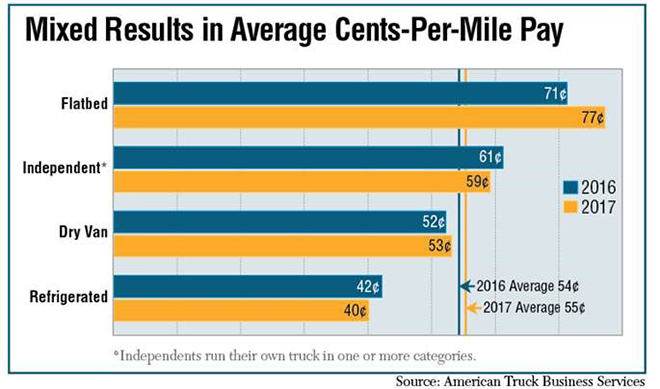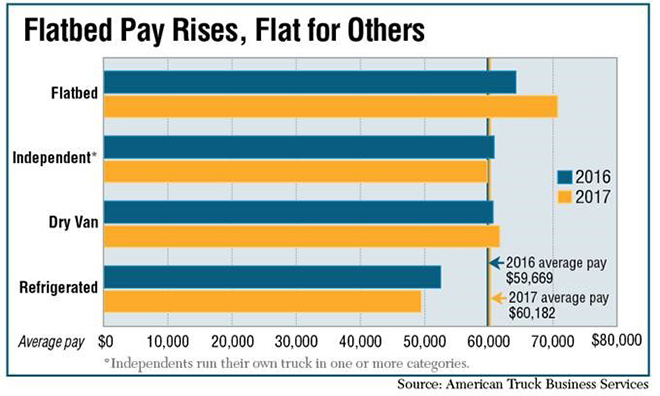Drivers Saw Modest Pay Raise in 2017

A study of nearly 20,000 truck company owner-operators found that the drivers on average earned a little more money in 2017 while driving slightly fewer miles. However, pay varied depending on what segment the driver worked: dry-van, refrigerated, flatbed or as an independent who worked in one or more segments.
Truck drivers on average drove 110,163 miles in 2017, down 0.5% from 2016. Average income rose $513, or 0.9%, to $60,182, according to the annual Independent Contractor Benchmarking report from American Truck Business Services, a Lakewood, Colo.-based accounting and consulting firm.
“It is not uncommon to see miles down but income/compensation up,” American Trucking Associations Chief Economist Bob Costello said. “It shows that base pay is rising significantly, making up for the drop in miles. This is also happening for company drivers.”
In ATBS’ four driver categories, independent drivers saw net income drop $1,048 to $59,529, while dry-van drivers saw it rise $1,048 to $61,472. The income of reefer drivers plummeted $3,007 to $49,267, and flatbed drivers saw it rise $6,518 to $70,477.

ATBS CEO Todd Amen said the mixed results are a reflection of the greater U.S. economy with some drivers struggling while flatbed drivers enjoyed a healthy jump in business as they carried materials used for construction.
“Reefers, independents got hurt. It’s still a tough market,” Amen said. “But flatbed was up almost 10%. These guys lead us out of a recession. They are carrying tractors, capital goods, housing materials.”
Amen summed up 2017 as a flat year with miles staying about the same. The average pay may have gone up but fuel costs went up as well. “They got 7 cents per mile more in revenue while fuel costs rose 5 cents per mile more,” Amen said.
That 5-cent increase meant an additional $5,467 in fuel costs while the 7-cent increase in revenue-per-mile generated on average an additional $6,714 for drivers. In total, drivers earned another $1,247.
The electronic logging device mandate brought another expense for owner-operators as they were required to install devices that electronically tracked their hours of service. That close watch on driver behavior appears to have put a ceiling on miles-per-year for most drivers, Amen said.
Last year’s 110,163 average miles may be “the capacity limit with ELDs. No matter how hard you work,” Amen said. “Some may do 125,000 but that’s unusual. I think you will see fewer miles this year as drivers will run less.”
There have been ups and downs for drivers since ATBS began conducting its benchmarking study in 2003 but business has improved, Amen said.

In 2003, there were 238,000 independent contractors who drove an average of 139,000 miles and earned $47,600, ATBS reported. In 2017, there were 268,000 contractors who drove an average of 110,000 miles and earned $60,182.
“People say owner-operators are dying off. It’s still a pretty good job,” Amen said. “Long term it looks good for them. They work less and make more.”
For instance, those numbers show drivers in 2017 earned 26% more than in 2003 while driving 21% fewer miles.
“That has been the trend in recent years but the numbers don’t show whether buying power is any greater today,” said Norita Taylor of the Owner-Operator Independent Drivers Association, a trade group with more than 160,000 members.
A consumer would need to earn $65,228 today to have the same purchasing power as someone earning $47,600 in 2003, according to the Bureau of Labor Statistics’ Consumer Price Index Inflation Calculator.
Amen remains optimistic for the independents.
“Drivers want to be owner-operators because they are in charge of their own life, they run their own business. That segment will grow,” Amen said.

